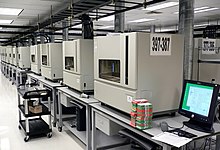
Back مسلسل الحمض النووي Arabic DNK sekvencer BS Sequenzierautomat German توالییاب دیانای Persian DNA-sekvensseri Finnish Séquenceur d'ADN French DNK sekvenator Croatian ԴՆԹ սեկվենատոր Armenian ڈی این اے سیکیوئنسر PNB Секвенатор ДНК Russian
 DNA sequencers | |
| Manufacturers | Roche, Illumina, Life Technologies, Beckman Coulter, Pacific Biosciences, MGI/BGI, Oxford Nanopore Technologies |
|---|---|
A DNA sequencer is a scientific instrument used to automate the DNA sequencing process. Given a sample of DNA, a DNA sequencer is used to determine the order of the four bases: G (guanine), C (cytosine), A (adenine) and T (thymine). This is then reported as a text string, called a read. Some DNA sequencers can be also considered optical instruments as they analyze light signals originating from fluorochromes attached to nucleotides.
The first automated DNA sequencer, invented by Lloyd M. Smith, was introduced by Applied Biosystems in 1987.[1] It used the Sanger sequencing method, a technology which formed the basis of the "first generation" of DNA sequencers[2][3] and enabled the completion of the human genome project in 2001.[4] This first generation of DNA sequencers are essentially automated electrophoresis systems that detect the migration of labelled DNA fragments. Therefore, these sequencers can also be used in the genotyping of genetic markers where only the length of a DNA fragment(s) needs to be determined (e.g. microsatellites, AFLPs).
The Human Genome Project spurred the development of cheaper, high throughput and more accurate platforms known as Next Generation Sequencers (NGS) to sequence the human genome. These include the 454, SOLiD and Illumina DNA sequencing platforms. Next generation sequencing machines have increased the rate of DNA sequencing substantially, as compared with the previous Sanger methods. DNA samples can be prepared automatically in as little as 90 mins,[5] while a human genome can be sequenced at 15 times coverage in a matter of days.[6]
More recent, third-generation DNA sequencers such as PacBio SMRT and Oxford Nanopore offer the possibility of sequencing long molecules, compared to short-read technologies such as Illumina SBS or MGI Tech's DNBSEQ.
Because of limitations in DNA sequencer technology, the reads of many of these technologies are short, compared to the length of a genome therefore the reads must be assembled into longer contigs.[7] The data may also contain errors, caused by limitations in the DNA sequencing technique or by errors during PCR amplification. DNA sequencer manufacturers use a number of different methods to detect which DNA bases are present. The specific protocols applied in different sequencing platforms have an impact in the final data that is generated. Therefore, comparing data quality and cost across different technologies can be a daunting task. Each manufacturer provides their own ways to inform sequencing errors and scores. However, errors and scores between different platforms cannot always be compared directly. Since these systems rely on different DNA sequencing approaches, choosing the best DNA sequencer and method will typically depend on the experiment objectives and available budget.[2]
- ^ Cook-Deegan, Robert Mullan (1991). "Origins of the Human Genome Project". FASEB Journal. 5 (1). University of Washington: 8–11. doi:10.1096/fasebj.5.1.1991595. PMID 1991595. S2CID 37792736. Retrieved 20 October 2014.
- ^ a b Metzker, M. L. (2005). "Emerging technologies in DNA sequencing". Genome Res. 15 (12): 1767–1776. doi:10.1101/gr.3770505. PMID 16339375.
- ^ Hutchison, C. A. III. (2007). "DNA sequencing: bench to bedside and beyond". Nucleic Acids Res. 35 (18): 6227–6237. doi:10.1093/nar/gkm688. PMC 2094077. PMID 17855400.
- ^ F. S. Collins; M. Morgan; A. Patrinos (2003). "The Human Genome Project: lessons from large-scale biology". Science. 300 (5617): 286–290. Bibcode:2003Sci...300..286C. doi:10.1126/science.1084564. PMID 12690187. S2CID 22423746.
- ^ Cite error: The named reference
a tale of threewas invoked but never defined (see the help page). - ^ Michael A. Quail; Iwanka Kozarewa; Frances Smith; Aylwyn Scally; Philip J. Stephens; Richard Durbin; Harold Swerdlow; Daniel J. Turner (2008). "A large genome centre's improvements to the Illumina sequencing system". Nat Methods. 5 (12): 1005–1010. doi:10.1038/nmeth.1270. PMC 2610436. PMID 19034268.
- ^ Li, Heng; Ruan, Jue; Durbin, Richard (2008-11-01). "Mapping short DNA sequencing reads and calling variants using mapping quality scores". Genome Research. 18 (11): 1851–1858. doi:10.1101/gr.078212.108. ISSN 1088-9051. PMC 2577856. PMID 18714091.